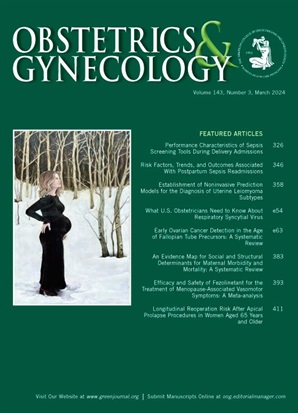Cost Effectiveness of Salpingectomy Compared With Vasectomy for Permanent Contraception.
IF 4.7
2区 医学
Q1 OBSTETRICS & GYNECOLOGY
引用次数: 0
Abstract
OBJECTIVE To evaluate the cost effectiveness of salpingectomy compared with vasectomy for couples seeking permanent contraception. METHODS We developed a decision tree model that used TreeAge to evaluate the cost effectiveness of vasectomy compared with salpingectomy for a hypothetical cohort of 800,000 people, the number of male and female patients who undergo permanent contraception procedures in the United States annually. Effectiveness was expressed in quality-adjusted life-years (QALYs), and the willingness-to-pay (WTP) threshold was set to $100,000 per QALY gained or lost. We derived costs, probabilities, and utilities from the literature, and estimated the incremental cost-effectiveness ratio (ICER) between the two strategies. We completed a probabilistic sensitivity analysis with 10,000 simulations and created a cost-effectiveness acceptability curve for WTP thresholds from $0 to $200,000. Secondary outcomes included the number of unintended pregnancies, ovarian cancer cases, and ovarian cancer deaths. RESULTS Salpingectomy was not a cost-effective strategy, with an ICER of $143,769 per QALY gained compared with vasectomy. Probabilistic sensitivity analysis showed that the chance of vasectomy being cost effective was 81.5% but decreased to 14.7% with a WTP threshold of $200,000. Annually, salpingectomy was associated with 1,215 fewer unintended pregnancies, 6,085 fewer ovarian cancer cases, and 4,921 fewer ovarian cancer deaths compared with vasectomy. CONCLUSION Salpingectomy is not cost effective compared with vasectomy at a WTP threshold of $100,000, despite lower unintended pregnancy rates and societal ovarian cancer burden. Shared decision making, including a discussion of the long-term health benefits of salpingectomy, is important for couples deciding on permanent contraception procedures.输卵管切除术与输精管切除术用于永久避孕的成本效益比较。
目的比较输卵管切除术与输精管切除术对寻求永久避孕的夫妇的成本效益。方法:我们开发了一个决策树模型,使用TreeAge来评估输精管切除术与输卵管切除术的成本效益,假设队列为80万人,即每年在美国接受永久性避孕手术的男性和女性患者的数量。有效性以质量调整生命年(QALYs)表示,支付意愿(WTP)阈值设定为每获得或失去一个质量调整生命年10万美元。我们从文献中推导出成本、概率和效用,并估计了两种策略之间的增量成本-效果比(ICER)。我们完成了10,000次模拟的概率敏感性分析,并创建了从0美元到200,000美元的WTP阈值的成本效益可接受性曲线。次要结局包括意外怀孕、卵巢癌病例和卵巢癌死亡人数。结果输卵管切除术不是一种划算的策略,与输精管切除术相比,每QALY获得的ICER为143,769美元。概率敏感性分析显示输精管切除术的成本效益几率为81.5%,但WTP阈值为20万美元时下降至14.7%。每年,与输精管切除术相比,输卵管切除术减少了1215例意外怀孕,减少了6085例卵巢癌病例,减少了4921例卵巢癌死亡。结论在WTP阈值为10万美元时,输卵管切除术与输精管切除术相比并不具有成本效益,尽管意外妊娠率和社会卵巢癌负担较低。共同决策,包括讨论输卵管切除术的长期健康益处,对决定采取永久性避孕措施的夫妇很重要。
本文章由计算机程序翻译,如有差异,请以英文原文为准。
求助全文
约1分钟内获得全文
求助全文
来源期刊

Obstetrics and gynecology
医学-妇产科学
CiteScore
11.10
自引率
4.20%
发文量
867
审稿时长
1 months
期刊介绍:
"Obstetrics & Gynecology," affectionately known as "The Green Journal," is the official publication of the American College of Obstetricians and Gynecologists (ACOG). Since its inception in 1953, the journal has been dedicated to advancing the clinical practice of obstetrics and gynecology, as well as related fields. The journal's mission is to promote excellence in these areas by publishing a diverse range of articles that cover translational and clinical topics.
"Obstetrics & Gynecology" provides a platform for the dissemination of evidence-based research, clinical guidelines, and expert opinions that are essential for the continuous improvement of women's health care. The journal's content is designed to inform and educate obstetricians, gynecologists, and other healthcare professionals, ensuring that they stay abreast of the latest developments and best practices in their field.
 求助内容:
求助内容: 应助结果提醒方式:
应助结果提醒方式:


